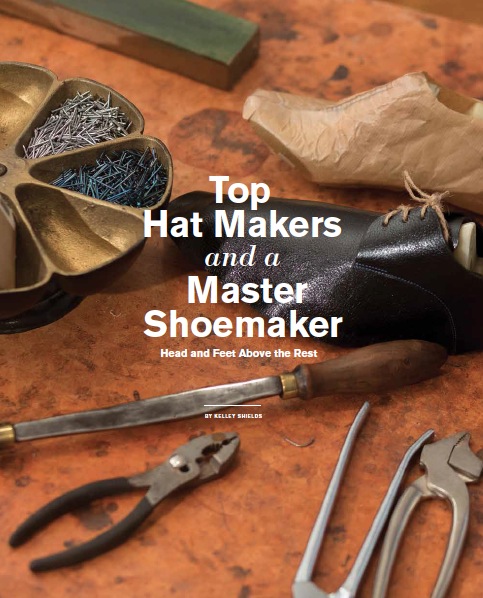
A shoemaker’s tools, and bespoke shoe in progress / photo by Joyce A. George
Most people will work to provide a living for themselves while only a small number will provide themselves the living they want to do through the work they choose.
Without question a smaller populace within the populous, those who follow their heart’s call are nonetheless a critically important segment of any community. It requires a particular quality of energy—a blend of vision, courage, tenacity, ingenuity and near boundless energy—to produce something people want, that the producer of said something additionally wants to provide. For the past 30 years this quality of energy, the magic of creativity to be succinct, has literally transformed the Williamsburg/Greenpoint area. This article profiles a few local creatives making beautiful hats and shoes that many of us want to own.
Some hats provide a finial effect, literally decorating the tip of our tops while others function more like shelter from the elements, housing our psychological centers. Others still are hybrids offering both exemplary style and housing which, following the metaphors of finial-hats and shelter-hats through would make the hybrid types, penthouses for the head!
This whimsical observation is brought to mind because two incredibly artful hatters in the area are about to join forces: Ryan Wilde, milliner-extraordinaire, proprietor/partner of the recently shuttered IDA (a collaborative venue launched in 2011 that showcased the assortments of Wilde and jeweler Georgia Varidakis) is joining Sean O’Toole’s venture, Pork Pie Hatters at 441 Metropolitan near Marcy—all of which is meaningful because their pairing is bound to provide a bounty of offerings across the finial-shelter-penthouse array.
Pork Pie Hatters, established in 2011 in the East Village, opened its Williamsburg location in 2012. Progeny of the long-established J.J. Hat Center in Manhattan, the story of how Sean O’Toole came to open two of his own shops is almost a cliché, but not actually because his is an interesting and satisfying story which clichés ultimately are not due to their utter predictability.

From left: Ryan Wilde, Sean O’Toole, and Colin. Photos by Ben Rosenzweig
Sean says working in a creative capacity always felt right, even though he admits not knowing for some time what exactly it was that he wanted to bring forth. Early on, during high school and then again after leaving college he found some degree of satisfaction in the restaurant business. He even thought for a while that his creative inclination might be answered by a career as a chef. It did not take too long however before he realized that designing meals and preparing food wasn’t fully satisfying his inclination to bring something into form.
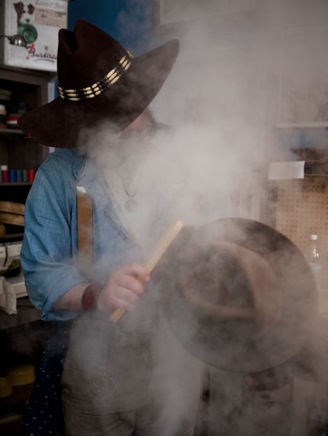 For 80 years the original J.J. Hat Center was operated out of 1276 Broadway in Manhattan. Founded by the Young family in 1911 then acquired by the Lambert family in the 60’s, the O’Tooles entered into the renowned venture in 1981, ultimately purchasing it in 1995. In 1991 it was moved it to its present location at 310 Fifth Avenue.
For 80 years the original J.J. Hat Center was operated out of 1276 Broadway in Manhattan. Founded by the Young family in 1911 then acquired by the Lambert family in the 60’s, the O’Tooles entered into the renowned venture in 1981, ultimately purchasing it in 1995. In 1991 it was moved it to its present location at 310 Fifth Avenue.
Sean’s parents were consummate retailers. They knew the buying and management ends of the business inside-out, but had no interest in exploring the design or production aspects of the hat industry. Like many parents they had high aspirations for their child and Sean enrolled at Pace University to study law. He said although he knew on day one of school that it was not what he wanted to do, it took three semesters to find the courage to tell them that his heart was not in law, it was in hats. He saw an opportunity in the L.E.S. where he was living at the time for a hat shop with the right assortment.
His parents were not initially supportive, but after a year of success for his first Pork Pie Hatters store on 9th Street between 1st and A, they stood behind his choice.
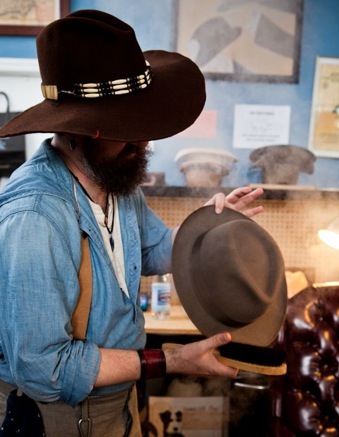
About a year after opening his first store Sean began to seek out opportunities to learn the basics of traditional hat making. He spent two weeks in a large-scale 100+ year-old hat manufacturing operation. Although he had a few basic Fedora blocks and was playing around with various techniques and materials, his stock was primarily a curated selection of styles from established hat lines. Two years later Sean’s inventory of crown blocks, flanges and machines was about to exponentially expand with his acquisition of Dave Brown Custom Hats. The seventy-four year old owner of the business was retiring and landed on selling to Sean because of his desire to learn from Dave. Part of the sales deal was that six times a year Mr. Brown will be working with Pork Pie Hatters, passing on his knowledge.
With uninspired over-development threatening to banalize the Williamsburg/Greenpoint area, it is thoroughly satisfying to walk into a shop and not only see the evidence of hand but to feel the artistic impetus that compelled the making of the objects for sale. When I dropped into Pork Pie Hatters my brain instantly recalled “Caps for Sale,” by Esphyr Slobodkina. I remembered how the joy of having that story read to me again and again was matched only by my learning how to read it myself. After a few moments in reverie of the stacks of colorfully patterned caps, skillfully balanced atop his head and the towers of them, leaning like Pisas to almost tipping while the peddler rested by the tree, the stunning assessment resulted that had there been one in the story, the peddler’s workroom would have looked just like Pork Pie Hatters. That the space very effectively and attractively pulls double-duty as a shop/workroom is certainly a bonus for Sean, but the profound pleasure for me was in the palpable sense of craft in progress.
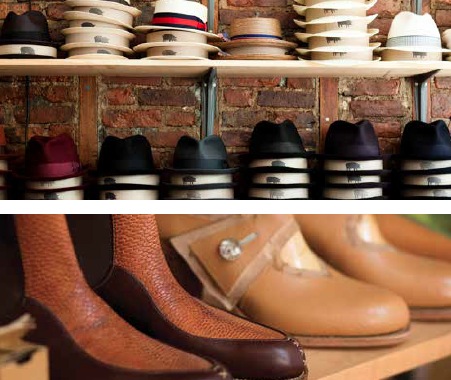
Top image by Ben Rosenzweig / Bottom image by Joyce A. George
Sean’s internally designed collection of hats bears the “Phrenology” label. His collection is produced in much the same way as hats have been made for 140 years; in fact some of the blocks he uses date from the civil war period. Because the standards of quality that the Phrenology line is made to limit the quantity that can be produced at his current scale, Sean also buys from classic collections, augmenting his inventory. The result is a fabulous, blended assortment of fairly but not exclusively traditional hats that will endure from both a style and quality perspective.
Maria Levitsky’s Water Tower Inspirations
The stacks of blocks teetering on display tables and the sewing machines, hand tools, steamers and spindles of ribbons behind the counter that naturally divides the workroom from the retail area in Pork Pie Hatters brought back memories of an early Williamsburg milliner’s studio from the late 80’s. Maria Levitsky, who is since, a photographic artist living in New Orleans, and rehabbing a historic house there, says the first hat she ever made was just another creative exercise; an answer to her love of “making things” in general. She recalls it was a hat of soft construction, a cone sewn atop a band, fashioned for her boyfriend. The hat garnered a lot of local attention, enough so to encourage her to try another, and then another, and another. She saw a Parson’s catalog in a friend’s studio on Berry Street one day, thumbed through it and came across a basic millinery continuing ed course.
That class inspired her take a follow-up course and from there her hats grew in both expression and exposure. Her one foray into retail success was a Barney’s order the fulfilling of which made it painfully clear to her that both designing and producing anything, hoping to reap profit after costs, is an art form in itself, one which she possessed not enough passion to pursue. I asked her about the area at that time, how it might have influenced her work. Maria shared how her environment—literally the view out her loft windows on N.10th—played into the development of some of her favorite forms and patterns. At a certain point she realized an oft-repeated hat silhouette recalled iconic water tower pinnacles atop their full-bodied drums and a patterned banding she put into frequent service was the same red and white checkerboard ringing the massive natural gas storage tanks that punctuated the Greenpoint horizon from 1927-2001.
Maria showcased her hats in salon-variety show venues in her loft up until the early 90’s. Personally recalling one of her hat/art/performance events I attended what comes to mind was a playfulness of expression, a broad liberation that ironically resulted from the somewhat sober or at least serious commitment of creating as a life path.
Milliner Ryan Wilde
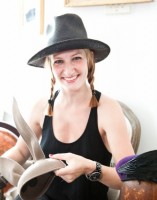
Milliner Ryan Wilde
And creating as a life path is precisely what came across while talking with Pork Pie Hatters’ new resident women’s collection designer, Ryan Wilde. I visited Ryan’s shop before it closed. The assortment of hats on display summoned to mind a similar blend of playfulness and commitment that Maria was exploring. The result in Ryan’s work is an undeniable authenticity of her love of both design and craft.
When asked about early influences she told me about her father, an illustrator-painter who relied heavily on photography, setting up reference shots from which he worked in a highly realistic style, and how playfulness as a life perspective emerged out of her participation in his work. “I grew up in the East Village which in and of itself was theater. But the type of painting my father did required detailed setups to work from which meant I was constantly in costume, dressed-up as anything and everything. I loved it.”
Ryan attended Syracuse University as a photography major, a parallel easily drawn from her father’s influence. She recalled solving her thesis assignment in Cindy Sherman-esque form, creating a faux pictorial autobiography, a solution she was prepared to execute given years of collaboration with her father posing always as someone other than herself. After college she moved to Europe during time which she discovered and nurtured a love of millinery.
A sister that she describes as “towering over her” perhaps inspired Wilde’s preoccupation with wanting to be taller, bigger—favoring high crowns, high heels and long extensions. “Hats allow a wearer to become a larger than life version of oneself.” She hopes her clients find the same release she does in the potential to play, to become a different self while wearing her creations.
I asked her about the W/G area, and how perhaps it has influenced the development of her work. Of Williamsburg she says she loves its appreciation of whimsy, of youthfulness and frivolity. Ryan’s hats have generated lots of press, they’ve been sold in Bendel’s and Patricia Fields, they’ve been featured in scores of editorial spreads and runways and are in the personal collections of celebrities and non-celebs alike. They are in a word: Special in both their design and their make, which means they are also expensive—for most wallets, but thankfully she has had a steady client base who can afford them.
Made entirely by hand (with the use of some machines operated by her hands) Ryan strives for perfection in the quality of her production but interestingly says she feels no pain in parting with her creations after such an intense association of bringing them into form.
The daughter of two visual artists (her mother is a sculptor) Ryan attests from personal experience that the difference between the satisfaction of making fine art and hats is in the end use. “Fine art just sits there, whereas hats have a useability” she says, that celebrates the life of the object beyond her hands. For Ryan it is the life beyond her workbench that captions the artistry of hat making.
We talked a bit about how hard it is to run a business and turn profit, especially with such labor- intensive products and how stifling the isolation of working in a vacuum can become. What Ryan was looking forward to most about joining Pork Pie Hatters is the daily interaction with a community of other hat-folk. She described being at a place in the development of her work where she is craving discourse and the exchange of ideas. Which makes a lot of sense; reaching a master level of ability in anything requires years of solitary focus. Having arrived at that place, collaboration is her most logical next step. Ryan’s extraordinary level of expertise applied to a women’s collection within Pork Pie Hatters’ established commercial breadth will without question result in gorgeous, exquisitely executed hats one feels compelled to own.
For some artists sharing their work in progress is critical to its development, while others prefer to bring peers in only at the end; in either case, sharing is a significant aspect. The need for community and collaboration in the creative process is in fact the reason why the Williamsburg-Greenpoint area evolved into the commercial and real estate phenom that it has become.
Pork Pie Hatters
441 Metropolitan Ave
Williamsburg, Brooklyn 11211
(347) 457-6519
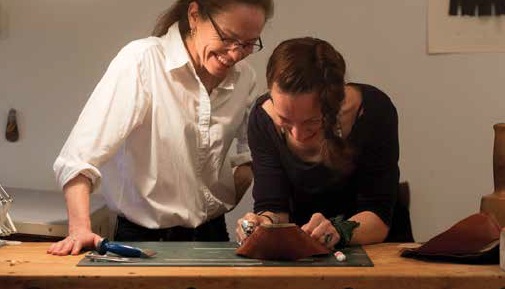
Jesse Moore (left) and Marika Chasse, master shoemakers, are opening a new shop on Grand Street this fall. Photo by Joyce A. George
Shoemakers Jesse Moore and Marika Chasse—Open Shop
The growth of this region is unequivocably tied to it having been seeded with artists who were seeking the community of like-minded others. A decline in manufacturing and shipping spanning the 40’s-60’s initiated a downward spiral in Williamsburg/Greenpoint and by the close of the crushing city-wide social and fiscal crisis of the 70s the two neighborhoods were largely undesirable if not somewhat blighted. In the early 80s, real estate in this area was down, which made large spaces for making, showcasing and selling work affordable. Enter the wood workers, dancers, musicians, visual artists, and designers.
The strong desire for community and collaboration also came up while talking to Jesse Moore, sculptor-turned shoemaker at 105 Grand Street.
The catalyst for Jesse’s transition from sculpture to shoemaking was a diagnosis of Multiple Sclerosis in 1997, a chronic autoimmune disorder of the central nervous system affecting movement, sensation and bodily functions which ultimately interrupted the production of her large-scale work nine years later. After the initial diagnosis Jesse recalls suffering on average three episodes a year, each one less severe than the preceding one which permitted her to keep producing for several years. Out of her then-studio on Roebling, Jesse continued to work in between the debilitating bouts on large-scale wood pieces intended for outdoor installations. A fearsome episode in 2006 forced a difficult decision. For Jesse, the category of sculpture she was contributing to was synonymous with long-term commitment. For many artists their process can be as important, in some cases even more significant, than the work they are producing. Being a sculptor who showed and sold work meant obligation to extended timelines. The complication of the progression of an unpredictable disease disturbed Jesse’s sense of process, significantly enough to decide stop making art altogether.
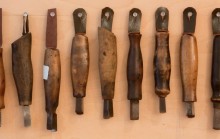
Photos by Joyce A. George
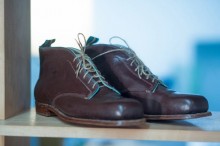
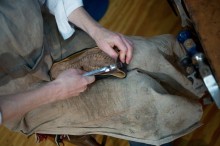
Jesse described herself as someone who has always been interested in how something was made, whether it be a chair, a house, food or clothing—a pair of shoes—it mattered not. The undercurrent was curiosity and the predisposition to working with her hands encouraged the exploration. Jesse made it clear that shoes were not a replacement for sculpture. She explained an interest in shoemaking had been skulking around the recesses of her creative hemisphere for years, so in 2007 when a friend mentioned a class she heard of going on in the L.E.S. on shoemaking, she decided to check it out. She found the process fascinating and viewed the investigation of it as a potentially inspiring period of rest. For years thereafter Jesse explored with terrific intensity (and at equally terrific financial expense) what might be the dying art of shoemaking entirely by hand studying with masters in London, Sweden.
I asked Jesse if she misses making sculpture. What she admitted missing surprised me at first, but then made sense. “I miss the ‘bang-to-fit’ aspect. The material I worked in, as unforgiving as it was, was ultimately in my control. Shoe making is incredibly exacting and demanding. With shoes you are concerned with millimeters. With the work I was doing I was creating on an entirely different scale—millimeters did not matter and when the measurements were a little off, the solution was simple—”bang-to-fit.” Art is subjective. Shoe making however has a measurable value in the end; they either fit properly and last, or they don’t.”
The non-subjective constraint attraction for Jesse reminded me a bit of Ryan’s stance on her preference for making hats over fine art—the useability of what is being made figures significantly into both of their perspectives. I asked Jesse about the solitary nature of such exacting work. Certainly making made-to-order anything involves interfacing with a client base but in Jesse’s case a pair of $2,000 custom shoes will require at most three fittings post-measurement for the last, a pair of wooden models of both feet executed by an outside expert.
“I also miss the ‘hive’ of activity that was part of my life as a visual artist. You are interacting with other artists while developing your work. Whether it was my studio arrangements that provided the opportunity for the exchange of ideas or gallery representation, as a visual artist I was interfacing with a community.”
Because the absence of that type of exchange in the work she is doing now as a shoemaker appears to be a palpable one I asked her about sharing her knowledge, whether or not she foresees wanting to pass what she has learned on.
“In Europe where the craft of shoemaking is divided into four strata of expertise: Designer, Cutter, Closer and Maker, one must complete eight years of preliminary training before one can begin to be paid for the work they are do while in Western boot/shoemaking, one artisan learns all the aspects. I am just coming up on that threshold, in the European tradition anyway, of beginning my mastery. So, no, I am not at this point leaning toward wanting to teach shoemaking but I recognize that there will be a point in time where I will not be able to do the most strenuous parts of it anymore. Shoemaking hurts. It causes the hands and fingers actual pain.”
Jesse went on to paint the loose picture of over the next few years, getting more into the design of the shoes while forging relationships with shoemakers at the top of their craft who she may ultimately pass the making off to. For now however the big shift in the development of her work is coming in the form of shop hours. Up until now relationships with clients were developed through the standard word of mouth, or dare I say “foot” scenario; someone would notice an outstanding pair of shoes on someone else’s feet and demand: “where did you get those!?”
She also reflected that her natural curiosity is one of liking the problems associated with figuring something out. With her increased mastery she noticed that the process of shoemaking, being both solitary and laborious, was running the risk of becoming another “studio” experience; meaning one of subjectivity.
“Every pair of shoes presents problems,” Jesse said, and the shoe-studio starting to feel like an art-studio meant I was not putting myself in contact with the problems of shoemaking. I want to engage more people so I have more problems to solve.”
The love of challenge, missing the “hive” of interaction and a desire to strategize a lasting position for herself in the niche has resulted in moving the workshop to the front of her 1st floor space, opening up a portion of the façade to include a ‘window-in’ to engage interaction and inviting a fellow master shoemaker, Marika Chasse, to share her studio.
The two plan come the end of October on opening the studio with limited hours on Saturdays as a shop featuring a range of co-designed, made-to-order styles, by size. Their bespoke work, which is by contrast made-to-measure, will continue individually out of the shared space.
“The collaborative line is really our effort to find a way to offer the luxury of a hand made shoes at a more affordable price. We are brainstorming ideas about how we can personalize the shoes made in sizes in various ways. We are both very excited to see how this goes, and we are really having fun with the collaborative part right now-since both of us have worked in pretty much isolation for a long time. We share a lot of tastes and ideas about shoes and fashion in general though we do have very different aesthetic voices.”
All art is obsession. Paintings, sculpture, music, text, dance, shoes and hats—all take form in response to a compulsion of some kind. For some creatives the compulsion focuses on specific materials and what manifests from the ongoing exploration of the material is secondary, while for other artists the form or category is the constraint being explored over and over again and the material is the variable.
The creative forces behind the collections at Pork Pie Hatters and the soon-to-open specialty shop featuring the handmade shoes of Jesse Moore and Marika Chasse fall into the second category: madly compelled artisans iterating wearable art, sometimes fantastically and often fabulously in felt, straw, gross grain, leather, linen, cotton, canvas and wool. The beauty in this story is the bridges these havens artisans built for themselves—by hand—between the two poles of working and creating.
Leave a Reply